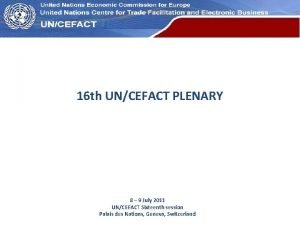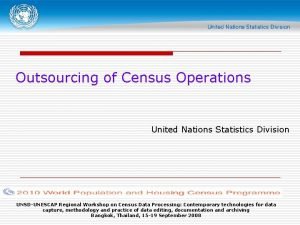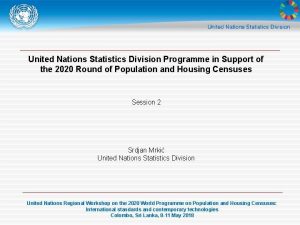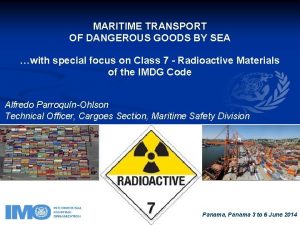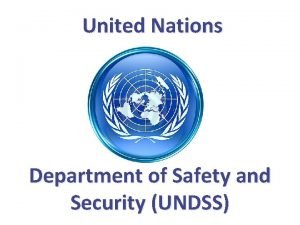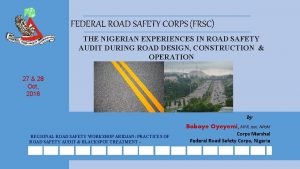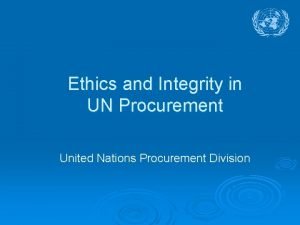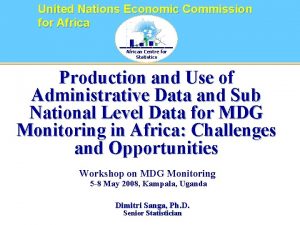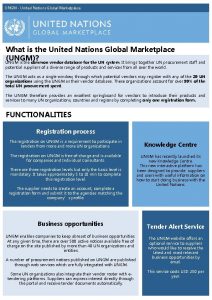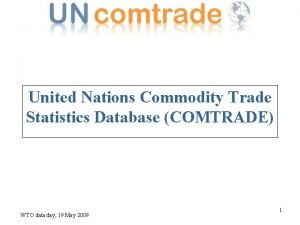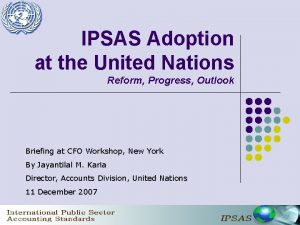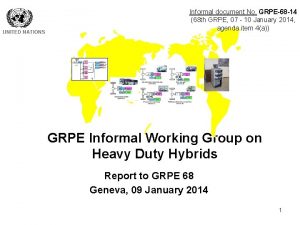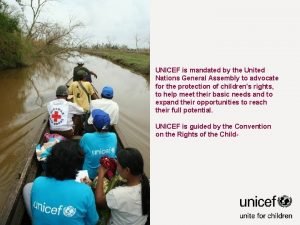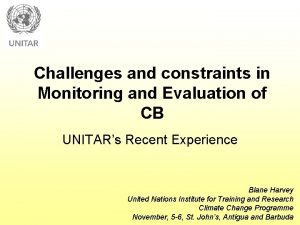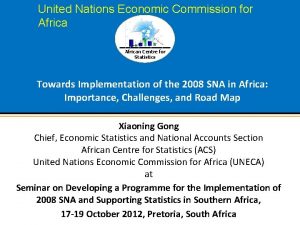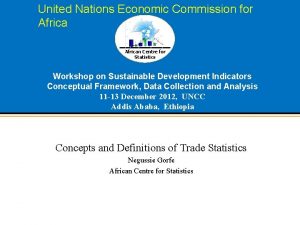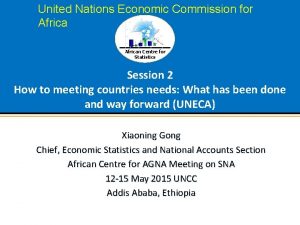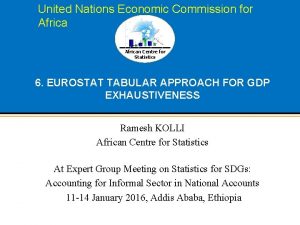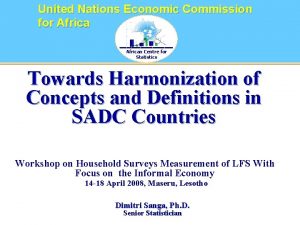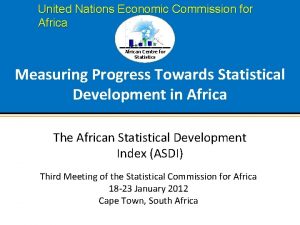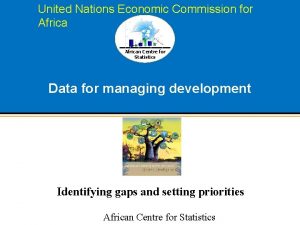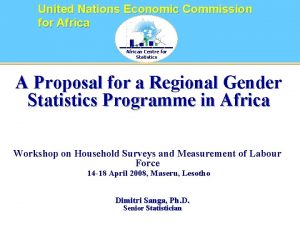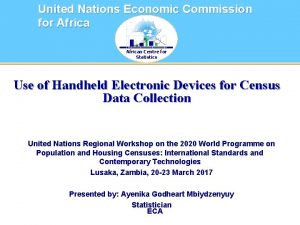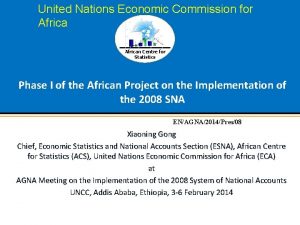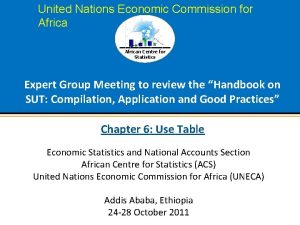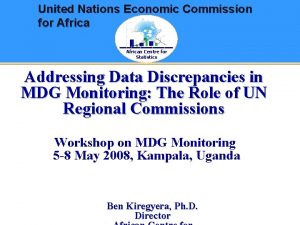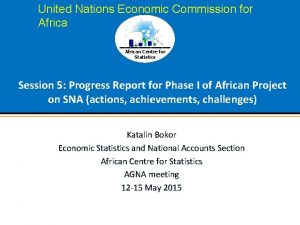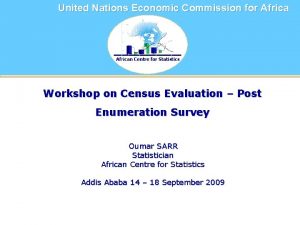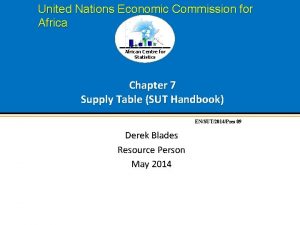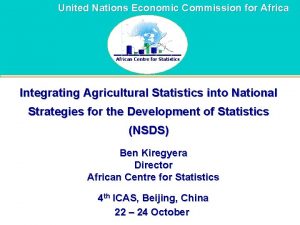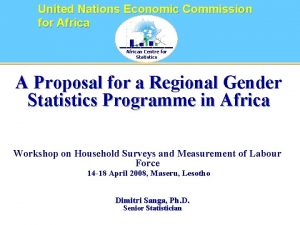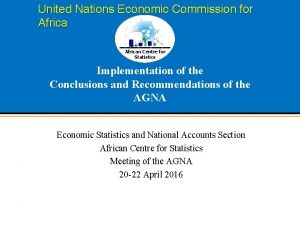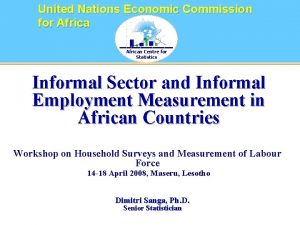United Nations Economic Commission for African Centre for





























- Slides: 29

United Nations Economic Commission for African Centre for Statistics Role of GIS and Remote Sensing to Environment Statistics Dozie Ezigbalike Data Management Coordinator African Centre for Statistics

A Definition • Environment statistics are statistics that describe the state and trends of the environment, covering the media of the natural environment (air/climate, water, land/soil), the biota within the media, and human settlements. » UNSD. 1997. Glossary of Environment Statistics, Studies in Methods, Series F, No. 67 African Centre for Statistics

Scope • Depends on: – Perception of major users and producers – Socioeconomic and environmental policies – Specific to particular conditions African Centre for Statistics

Integrative • Environment Statistics bring together: – Human activities – Natural events – Impacts of activities and events on environment – Social responses to impacts – Quality and availability of natural assets African Centre for Statistics

Interdisciplinary Modelling Problems • Interdisciplinary nature calls for synthetic presentation of data from various subject areas and sources • Characteristics of databases from various disciplines differ, specific examples for bio-physical databases: – Environmental variables based on scientific readings from instruments – Map data from ground surveys and remote sensing imagery – Sampling frameworks based on spatial rather than population distributions African Centre for Statistics

Framework vs System • Environment statistics do not lend easily to “system” modelled on entities and bookkeeping, such as SNA • Instead, framework in the form of a logical structure for organizing information Framework for development of environment statistics African Centre for Statistics

Approaches • Media approach: organizes environmental issues from the perspective of the major environmental components of air, land, water, and the humanmade environment • Stress-response approach: focuses on impacts of human intervention with the environment (stress) and the environment's subsequent transformation African Centre for Statistics

Approaches … • Resource accounting approach: aims at tracing the flow of natural resources from their extraction from the environment, through successive stages of processing and final use, to their return to the environment as waste or to the economy for recycling • Ecological approach: include a variety of models, monitoring techniques and ecological indices in a broad field that could be characterized as "statistical ecology" or "ecological statistics" African Centre for Statistics

FDES • A Framework for the Development of Environment Statistics • Combines media and stress-response approaches • Developed by UNSD in 1984 • Endorsed by Stat. Com in 1995 • Relates components of the environment to information categories African Centre for Statistics

FEDS Information categories Components of Social and Environmental the economic impacts of environment activities, natural activities/events 1. 2. 3. 4. 5. 6. Responses to environmental impacts Inventories, stocks and background conditions Flora Fauna Atmosphere Water Land/Soil Human Settlement African Centre for Statistics

GIS for Visual Presentation • Environmental phenomena are location-based and better presented as maps • Compare: African Centre for Statistics

GIS for Richer Content • Now compare last map of % of forest cover with actual vegetation cover • Richer content for more detailed analyses • GIS provides better data modelling for environmental phenomena African Centre for Statistics

Points: Earthquake locations • Location of each point stored in GIS • Attributes of each point stored in relational database – E. g. , date, magnitude, damage, fatality, etc. African Centre for Statistics

Symbolized by Magnitude African Centre for Statistics

Pin Maps • “Pins” are placed at the point locations and attributes from the database are displayed on clicking the pin symbol • Pins may be symbolized by attribute to present at-a-glance information African Centre for Statistics

GIS for Data combinaton • Even though FEDS organizes data in categories, we still need to combine and integrate them for visualization and policy analysis • Common criterion for selection of data for such combination is location • Therefore we need a tool that can select and combine data on the basis of the location Geographic Information System (GIS) African Centre for Statistics

Overlay African Centre for Statistics

Final Enlargement!! Forest - Deciduous Forest - Coniferous Scrub / Shrub Grasslands Barren/Sparsely Vegetated Urban / Built up Agriculture - Rice Fields Agriculture - Other Wetlands - Mangroves Water Ice/Snow No Data / Clouds / Shadow African Centre for Statistics

Remote Sensing • But how do we collect the surface characteristics from every point for these detailed analyses? African Centre for Statistics

Satellites can detect a wide range of reflected or emitted frequencies of electromagnetic radiation. http: //rst. gsfc. nasa. gov/Intro/Part 2_1. html African Centre for Statistics

United Nations Economic Commission for African Centre for Statistics

Data indicating different amounts of reflected radio waves can be used to generate a “false color image” of rates and types of precipitation. http: //www. google. com/webhp? hl=en African Centre for Statistics

Remote sensing for more detailed data capture • Evapo. Transportation African Centre for Statistics

Mean Temperature African Centre for Statistics

Soil Moisture African Centre for Statistics

Analysis and Modelling • With detailed location specific data, we can now use the power of to answer complex spatial queries and what if …? Scenarios African Centre for Statistics

Food Security Modeling using Landcover Africa Geospatial I&W: Regions at Risk Population (Food-Water) Risk Surface Water Vulnerability Capacity (food + water vulnerability) x (capacity) Geo. Cover LC Integrated into each model Total Potential Food Supply Very High (Stress) Very Low (Stress) African Centre for Statistics

To Conclude • Remote sensing allows the collection of detailed data about bio-physical characteristics that cannot be collected by questionnaires • GIS allows the data, even questionnaire data to be visualized graphically • It allows the combination of data based on their location • And the complex combination for analyses African Centre for Statistics

African Centre for Statistics
 United nations economic commission for europe
United nations economic commission for europe African nations gain independence
African nations gain independence United nations statistics division
United nations statistics division What is the role of the united nations?
What is the role of the united nations? United nations statistics division
United nations statistics division Class 7 dangerous goods
Class 7 dangerous goods United nations zambia
United nations zambia Undss security
Undss security United nations
United nations Frsc vision and mission
Frsc vision and mission The agency sponsored by the united nations that compiles
The agency sponsored by the united nations that compiles Anatolia college mun
Anatolia college mun Ethics and integrity at the united nations
Ethics and integrity at the united nations United nations staff union
United nations staff union United nations
United nations Ungm
Ungm United nations flag
United nations flag Christian saunders united nations
Christian saunders united nations Commodity trade statistics database
Commodity trade statistics database Introduction to model united nations
Introduction to model united nations Ipsas united nations
Ipsas united nations United nations
United nations United nations
United nations United nations basic principles on the role of lawyers
United nations basic principles on the role of lawyers Six main organs of the united nations
Six main organs of the united nations Conclusion of cold war
Conclusion of cold war Unicef is mandated
Unicef is mandated Challenges in monitoring and evaluation
Challenges in monitoring and evaluation Opsp united nations
Opsp united nations Un introduction
Un introduction
